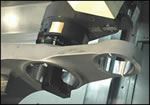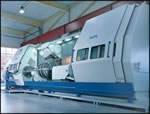U Axis Expands Internal Multitasking Machining
The promise of multitasking or complete machining continues to be realized in shops applying the technology. Driven by a need to manufacture workpieces complete in a single handling, machine tools that efficiently blend the operational capabilities of turning, milling and drilling in a single platform continue to evolve.
Share




The promise of multitasking or complete machining continues to be realized in shops applying the technology. Driven by a need to manufacture workpieces complete in a single handling, machine tools that efficiently blend the operational capabilities of turning, milling and drilling in a single platform continue to evolve.
At the EMO show in Milan, Austrian builder WFL Millturn Technologies demonstrated a new variation on the multitasking concept. In addition to conventional five axes turn/mill/drill capacity (B, C, X, Y and Z axes), the company’s new machine offers U axis on the milling spindle.
Traditionally found on machining centers and boring mills, the U axis allows the use of servo controlled facing heads and expandable boring bars for complex ID machining. On the multitasking machine tool platform, application of the U axis makes the manufacture of large-scale valves and complex ID aerospace components practical in a single set-up.
On applications in which deep-hole drilling operations are not concentric all the way through, using a conventional boring bar is prohibited because of length to diameter limitations. Bores that call for one or more different diameters, pockets and ID contours are best manufactured using special boring bars with expandable cutting edges. It’s the U axis that actuates these expanding cutters.
On the Millturn machine, the tool is clamped securely to the face of the milling spindle using a prism-type toolholder. Under CNC, the milling spindle is slowly rotated actuating the drive mechanism within the stationary boring bar.
Rotating the main spindle and traversing the bore in the longitudinal axis accomplishes metal removal. The cutting edges of the boring bar are expanded and contracted per the NC program—creating the ID contour. The interpolation of the longitudinal motion and the radial motion of the cutting edges produces the complex internal contours.
Face milling heads can also be used on the machine. The function of these facing heads is similar in principle to controlled quills on machining centers. In spite of the weight of these heads, B-axis and Y-axis flexibility are retained for attacking the workpiece at various angles.
The rotating milling cutter is driven from the main milling spindle and the actuation of the cutting edges is performed by the U axis. Applications for this attachment include sealing surfaces and grooves.
As with the facing head, eccentric deep hole drilling can be performed using the milling spindle to drive a rotating milling cutter. The U axis is employed to expand and contract the cutting edges of the rotating milling head while the workpiece is stationary.
Flexibility is the key performance attribute of multitasking machines. As this technology continues to evolve, the lines that traditionally define a milling machine and a turning center will become even blurrier.
Related Content
-
How to Troubleshoot Issues With Tool Life
Diagnosing when a tool is failing is important because it sets an expectation and a benchmark for improvements. Finding out why gives us a clue for how to fix it.
-
Orthopedic Event Discusses Manufacturing Strategies
At the seminar, representatives from multiple companies discussed strategies for making orthopedic devices accurately and efficiently.
-
Form Tapping Improves Tool Life, Costs
Moving from cut tapping to form tapping for a notable application cut tooling costs at Siemens Energy and increased tool life a hundredfold.



























